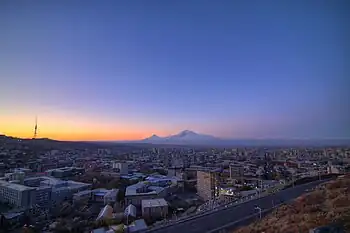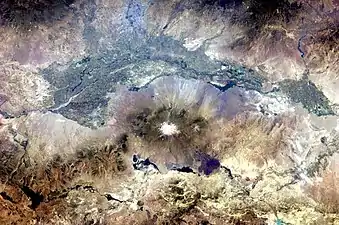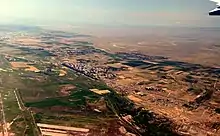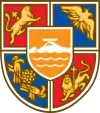

The Ararat Plain (Armenian: Արարատյան դաշտ, romanized: Araratyan dasht[lower-alpha 1]), called Iğdır Plain in Turkey (Turkish: Iğdır Ovası),[1] is one of the largest plains of the Armenian Highlands. It stretches west of the Sevan basin, at the foothills of the Gegham mountains. In the north, the plain borders on Mount Aragats, and Mount Ararat in the south.
It is divided into two sections by the Aras River, the northern part located in Armenia, and the southern part in Turkey.[2] The Turkish part of the plain is an Important Bird Area.[3]
Etymology
The Medieval Armenian historian Movses Khorenatsi recorded in his History of Armenia that the Ararat plain was named after King Ara the Handsome, the great-grandson of Amasya.[4]
Climate
The Ararat Plain and the Sevan basin experience abundant sunshine and are the sunniest areas in Armenia, receiving about 2,700 hours of sunshine a year. The shortest duration of sunshine is in the mid-mountain areas of the forest zone (about 2,000 hours). In the foothills, there is rarely a sunless day between the months of June and October.[5]
Agriculture
The Ararat Plain makes up 4% of Armenia's total land area, but yields 40% of the country's farm production.[5] In the Turkish part of the plain, apricot is widely produced on a 1,525 ha-area.[6]
Archaeology
This area has been inhabited since the Neolithic or the Early Chalcolithic times.
At Aratashen, first pottery appears at the end of the fifth millennium BC, or before 4000 BC.[7]
Gallery
 Khor Virap Monastery, Armenia, and Mount Ararat.
Khor Virap Monastery, Armenia, and Mount Ararat. Satellite image
Satellite image Map of Ararat Plain and it's land use.
Map of Ararat Plain and it's land use.
Notes
- ↑ Reformed spelling: Արարատյան դաշտ
References
- ↑ "Iğdır Ovası" (PDF) (in Turkish). Doğa Derneği. Retrieved 21 December 2021.
- ↑ Dowsett, Charles. "Armenia". Encyclopædia Britannica. Retrieved 10 January 2015.
- ↑ "Iğdır Plain". BirdLife International. Retrieved 16 May 2020.
- ↑ "Mount Ararat Expedition!". Ararat Expedition. Retrieved 10 January 2015.
- 1 2 Petrosian, Irina; Underwood, David (May 15, 2006). Armenian Food: Fact, Fiction & Folklore. LuLu. p. 23. ISBN 1411698657.
- ↑ "İlimiz" (in Turkish). Iğdır İl Tarım ve Orman Müdürlüğü. Retrieved 16 May 2020.
- ↑ Ruben BADALYAN, Pierre LOMBARD, THE NEOLITHIC AND CHALCOLITHIC PHASES IN THE ARARAT PLAIN (ARMENIA): THE VIEW FROM ARATASHEN (PDF file) 2004


